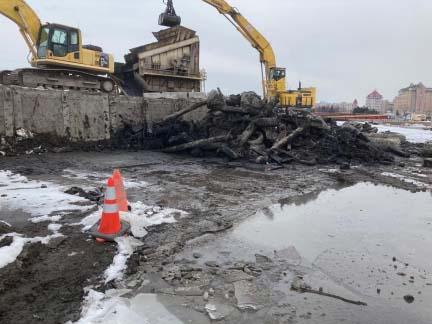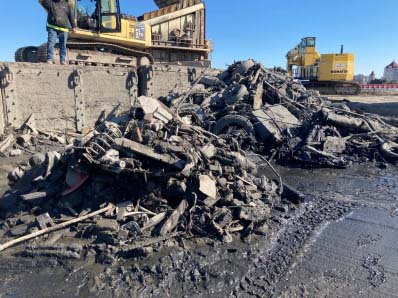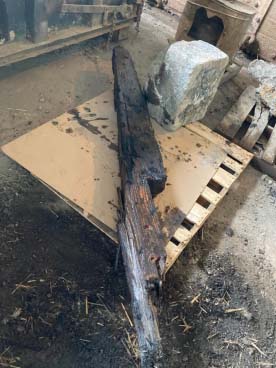INTRODUCTION
Dredged material is processed according to the Level 1 Archaeological Monitoring protocol outlined in the draft Cultural Resource Monitoring Plan (revised September 2020). This protocol calls for dredged soft sediments to be placed directly into barges, floated to the processing facility, and screened over bars on a vibrating platform. Items removed during the vibratory screening process are then sorted by trained personnel as per the Cultural Resource Monitoring Plan. Items of potential interest (possible artifacts or objects of local interests) are placed in a separate stockpile and photographed daily for archaeologists to review. These items are then placed in a holding area for archaeologists to inspect. To date, the vast majority of the recovered items consisted of modern debris and timbers.
RESULTS
An archaeologist conducted scheduled site visits on 2/22/21 and 2/26/21 to review the recovered items in person with the assistance of a dredge material processing facility machine and operator to sort through stockpiled items. Photographs were taken of stockpiled items.
Photographs of the latest material were reviewed prior to the site visits. The material was spread by machine on a flat hard surface to allow for an archaeologist to clearly review them (Photographs 1 and 2). Any item of potential interest was separated, rinsed and assessed. The material reviewed on both dates consisted of the same type of debris in the same condition: concrete fragments, rocks and timbers and pieces of wood, tires, miscellaneous metal and car parts (Photographs 3, 4 and 5). Two items were recovered on 2/22/21 and are recommended for retention and further assessment: A small, 2’-tall, riveted copper tank with nozzle and latch (Photographs 6 and 7), and a miscellaneous piece of notched timber (Photograph 8).



after it was spread out for viewing, front view.





ITEMS SEPARATED FOR FURTHER REVIEW
The archaeologist retrieved two items to retain for further analysis: one riveted copper tank with nozzle, and one miscellaneous notched timber.
CONCLUSIONS AND RECOMMENDATIONS
The archaeologist concludes that two items, a copper tank and a notched timber, recovered during the sediment screening retain possible historic/archaeological significance. Therefore, the archaeologist recommends that copper tank and notched timber be retained for further analysis and possible documentation. Per the draft Cultural Resource Monitoring Plan, the archaeologist further recommends that all the non-historically/archaeologically significant debris that has been reviewed by the archaeologist as of 2/22/21 and 2/26/21 may be disposed of.


